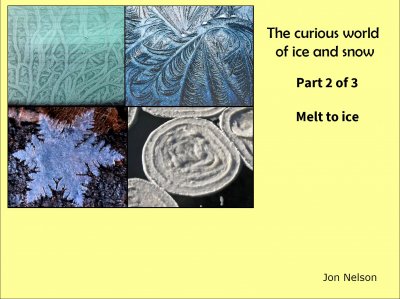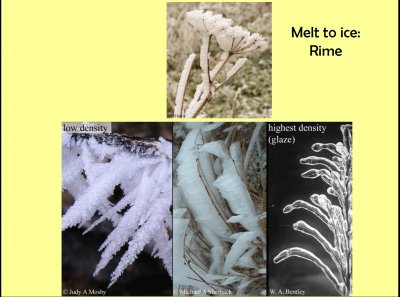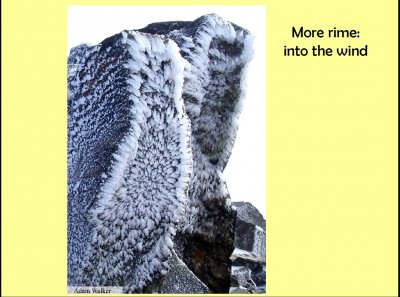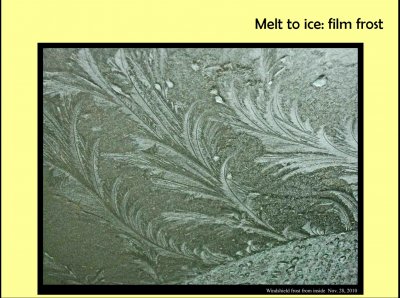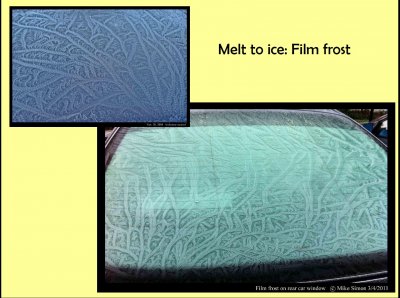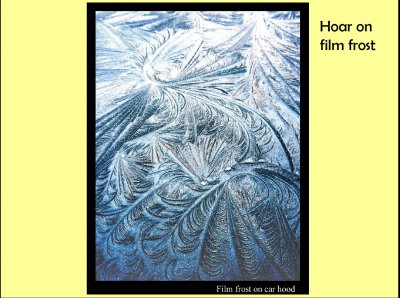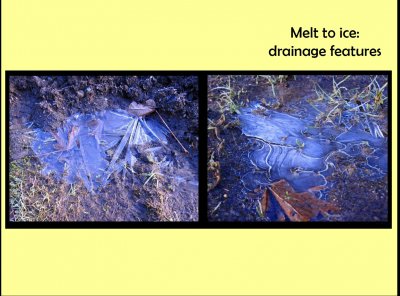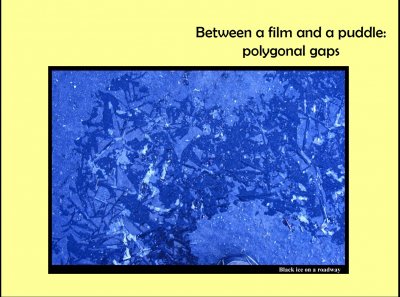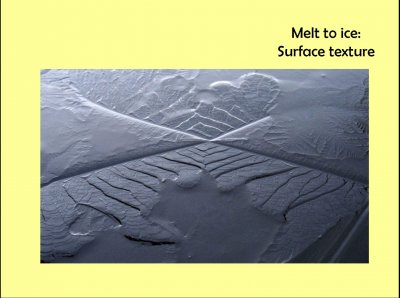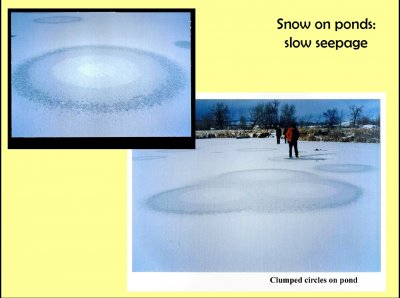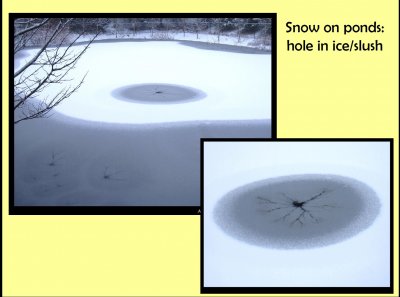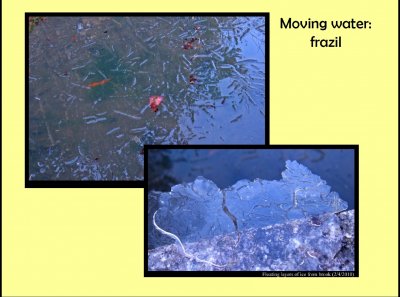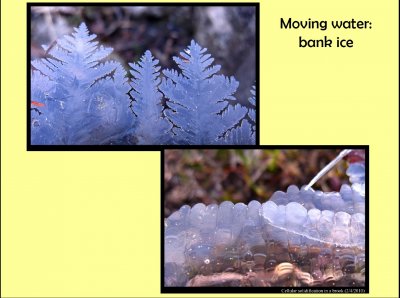| « The Curious World of Ice and Snow: Part 3 of 3 | The Curious World of Ice and Snow: Part 1 of 3 » |
The Curious World of Ice and Snow: Part 2 of 3
As I mention in Part 1, these are slides I gave for a Science Cafe discussion session in 2012. This section focuses on ice that forms directly from the melt, that is, the liquid phase. Contrast these cases with those in part 1 in which the ice grew from the vapor. Some of these cases might seem a little familiar, but many ought to seem downright bizarre.
As always, click on an image to enlarge it.
The contents here are emphasized in green font below. The underlying difference between ice growth from vapor and from melt is that the melt is much denser. The higher density means that vastly more water molecules can impinge on the ice surface in a given time and area. This higher impingement usually means faster growth and larger crystals, but the way that the melt reaches the crystal influences the form, and the result is not always so obvious. In fact, I would even say that it is never obvious.
OK then, let's get right back into it.
In the case of rime, supercooled droplets strike a sub-zero surface. That is, the droplets are below 0 C (32 F) and the surface is also below 0 C. So when the droplet hits, it almost always freezes. More and more droplets hit near the same spot, and the ice builds up, growing in a direction towards the wind. Often, each frozen droplet is small and rime is quite bumpy. Such rime will be white.
From a distance, the white tinge on objects with rime may look like hoarfrost, but there are some obvious differences. As the pictures above show, the white ice tends to be on just one side of an object, and often sideways and slightly downward. In contrast, hoarfrost tends to grow normal, or perpendicular, to the surface, often longest pointed upwards. Also, rime tends to have thicker and longer deposits, with less air space within. This is because, as mentioned above, growth from the melt tends to be faster, resulting in bigger pieces of ice.
When the temperature is nearer freezing the melt might stay on the object longer and freeze much slower while smoothing out the bumps. In this case the freezing likely warms the object up to very near the melting temperature (32 F, 0 C), resulting is a clearer, smoother glaze. See the image above, far right.
The direction of the rime deposit shows how the wind blew around the object. In this case, you can see how the wind on this mountain blew towards and around the edges of this rock.
A common sight in on windows in days of yore was the wonderfully fanciful fernlike patterns on windows. In those cases, the ice formed in a relatively thick melt layer on the inside of single-paned windows. Now, nearly all dwellings in regions with cold winters have double-paned windows and central heating, making this "film frost" in houses a thing of the past. However, these patterns are still common on outside surfaces, not just windows. The three main ingredients are i) a relatively smooth surface, ii) a fairly thick melt layer on that surface that iii) experiences a relatively quick cooling. Car surfaces are primo locations for this to happen. The above is the outside windshield of a car.
The top case above was on a sunroof of a car, and the bottom right was the rear window of a different car on another day. This particular pattern is bizarre, and I've seen it only on glass surfaces.
The swirly pattern above was the first case I saw. It was on the front hood of a black car (black provides good contrast). I had until that time been focused on observing ice on the ground and other natural objects. But walking past this car, this huge, beautiful whirling pattern just jumped out at me, and I started taking photos. That same black car provided many other cases of film frost on later days and later years, providing me with hundreds of photos. This particular case still baffles me because the white parts were very thick, several millimeters over the bare black surface, but had a foamy texture, not like fresh hoarfrost. But it helps illustrate that film frost usually also has subsequent hoar growth from the vapor.
In Japan, I would often walk around rice fields, looking for ice in puddles and other places. This one farmer had a few discarded bathtubs that seemed to serve the purpose of collecting water. Sometimes, I happened upon the tubs just as their top surface was starting to freeze over. When ice starts forming in the middle of a free melt surface, you can hardly discern it. In this case, I saw just part of the crystal, but when I carefully removed it with a pair of chopsticks, I was delighted to find that it was this large, nearly symmetric crystal. This crystal is very thin, probably about 10 sheets of regular paper or less in thickness, yet nearly two inches across. To some, it might look like a snow crystal, but it has many significant differences (other than its large size).
When a puddle freezes, it usually freezes its top surface first. In dirt, you often find them hollow. I call them "crunchy puddles". Drainage of the water makes them hollow, and probably in most cases, this drainage is due to ice growth in the nearby ground. But you notice what is left behind is not a smooth sheet of ice, but one with straight lines, like in the picture at left, and one with curves, as shown in the picture at right. Both straight and curved often occur in the same puddle, and they arise during different parts of the freezing process.
What we call "black ice" is clear ice without an air gap between it and the ground, as shown in the picture above. Most of this ice is firmly attached to the pavement below, but in a few spots there is an air gap, making that particular spot appear white.
The black parts are darker than the underlying pavement for the same reason that wet pavement is darker: light that strikes these regions is more likely to get absorbed in the pavement due to several factors. One of these factors is that the key property of light propagation in any material, the "index of refraction", is more similar between pavement and ice than that between pavement and air. The more similar this property is, the greater the amount of light transmission, and the corresponding lessor amount of light reflectance. Ergo, it is darker.
This case is also interesting because it also has straight lines and gaps, just like some crunchy puddles. Where did this water go? I think it flowed sideways, under neighboring ice, but that theory hasn't been well-tested, though it is consistent with other observations.
The surface of the melt can have a lot of texture, even when it does not have any obvious drainage. The above picture shows several distinct patterns. How they form remain a mystery, at least to me.
When a thin layer of ice forms on a pond, and then snow falls on the ice, the ice gets pushed down. Unexpected patterns can result, including the above circles. In this case, as you can see, the ice was thick enough to walk on. At the time, we didn't understand how the concentric bands could form like this. I recently heard that my colleague at the time (wearing the red coat) published an explanation a few years later. I will describe the mechanism in a later posting.
The branching-spidery pattern in the case above has a more obvious cause. The snow above the ice built up a thin layer, and by pushing down, melt flowed out various holes. Some of the melt spread out slowly and uniformly, making the circular pattern in the snow, but there was also a more rapid flow that instead made the narrow channels. Patterns like this are known as "viscous fingering" in the scientific literature.
Ice that forms on moving water, moving along with the water and wave, is generally known as "frazil" or "frazil ice". The above picture shows a case from a small creek that was flowing very slowly. I rarely have the opportunity to observe ice on moving water, so I do not know how common this type is, but I have not seen it described anywhere. The surface, in the larger picture at top left, looked a little different than ice that I usually see on a stagnant surface, as the relatively straight lines were short and had some bumpiness to them.
I reached in and pulled out some ice and was surprised to find it consisted of numerous thin layers that slid on one another, like a fresh set of cards. You can see the layers in the picture at bottom right. But I still don't understand the straight lines.
The ice anchored to the bank tends to instead consist of just one layer. When the adjacent melt is nearly stagnant, the more familiar fern-like shape results as shown at top. But I've also seen the very different pattern shown at bottom. I think this latter case occurs near more rapidly flowing melt. It appears to consist of parallel fingers, or "cells". But notice the nearly even spacing of the cells. Both types of crystallization is studied in other materials, the top called "dendritic solidification", the bottom "cellular solidification".
One day an aquaintance sent me these pictures of white discs floating in a side pool of slightly trapped water of the Nooksack River. The temperatures had been significantly below zero (32 F) for days, so it was much colder than usual. She wondered what they could be and how they formed. I'd never seen them, and didn't see anything quite like them on the Internet, but they appear to be discs of frozen foam. As to why they have concentric ridges, two factors may be important: 1) The relative amounts of foam build-up to amount of bumper-car jostling may vary from day to night. Presumably, there is less jostling at night or more build-up of new foam, but in the day the jostling pushes up the ridges when the foam is a little warmer. 2) The temperature reaches a maximum once per day, and around this time the foam is softer, allowing collisions with other discs to push up ridges to a greater extent. I'd guess that 2) is the major reason, but with only one case passed along second-hand, more observations are needed. Please be on the lookout.
Observations like these have taught me that I never know what I might find on an icy day.
This ends section two of the Science Cafe talk. Section three will follow.
--JN
